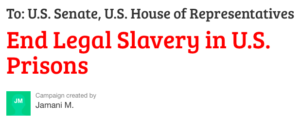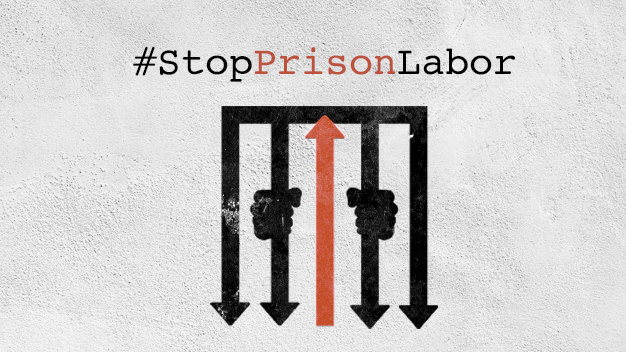Neither slavery nor involuntary servitude, except as a punishment for crime whereof the party shall have been duly convicted, shall exist within the United States, or any place subject to their jurisdiction.The amendment let slavery continue to exist when it came to prisons. It is imperative that we know the process under which the amendment was ratified so that we can understand the turbulence of the amendment’s history.
The Context: Fiery Debate in Congress and Ratification in 1865
After Lincoln’s 1863 Emancipation Proclamation, there was a rush to draft an amendment that would abolish slavery. Namely, a Representative from Ohio named James Ashley drafted a moderate amendment so that he does not alienate others from ratifying the amendment. This amendment that would have an enforcement clause added to it would be sent to the floor of the Senate for debate. The debate was fiery, with the two main parties at the time, the Republicans and Democrats, being intensely split. The Republicans supported the amendment while the Democrats vehemently opposed it. Democrats like Lazarus Powell from Kansas kept appealing to white supremacy, saying that African-Americans had decrepit urges and would hurt themselves while acting on them, so Caucasians should be enslaving them. Senators like Charles Sumner openly supported and radically pushed for it. In spite of the strong pushback from Democrats, the amendment passed the Senate. The amendment then went to the floor of the House for debate. The acrimonious debate continued to rage as the election of 1864 was occurring, and the Civil War was winding down. Many looked ahead to Reconstruction when the nation would have to inevitably rebuild from the war’s destruction. The Democrats stiffened their opposition to the amendment, and the Republicans still grounded themselves in their support. After an intensive campaign at the end of 1864 led by Republicans, the amendment was passed with a celebration in January 1865. The ratification might seem like a happy ending: slavery was abolished and was never a problem again. That assumption is very much mistaken.The Problem: The Issue Of Mass Incarceration and Slavery in Prisons
Slavery was still practiced under the clause in the amendment that allowed for slavery to exist in prisons:Neither slavery nor involuntary servitude, except as a punishment for crime whereof the party shall have been duly convicted, shall exist within the United States, or any place subject to their jurisdiction.
 Because of how loose the clause was, many people in the South began to exploit it as the old system that relied on slavery out in the open began to break down. Many black codes, racist laws passed during Reconstruction, criminalized lack of unemployment and residence, among others. Blacks were also arrested for very minor crimes. These codes put black people into the cycle of slavery as they were leased out for work, and when they would be released, they would simply be rearrested because they couldn’t find employment, and the cycle would continue. This would create an imprint on the American mind that blacks were “criminal”.
The problem of race and crime would continue into the 20th century. With the Civil Rights movement gaining steam, and opposition from whites and crime going up, politicians would declare that giving black people their rights was giving them free rein to commit crimes. This sentiment gave birth to an era of “tough on crime,” especially cracking down on drugs. These new policies especially impacted minority communities across America, forcing them into prison while Caucasians didn’t feel the same effects. Since many minorities were impoverished and used drug selling as a separate income, the so-called “War on Drugs” was essentially a war on minority communities.
This problem was only exacerbated through the American Legislative Exchange Council or ALEC, which is a group that essentially gives corporations access to government. Private prison companies began to gain a say in how prisons are run, and because they focused on their bottom line, they were able to make money off of mass incarceration through mandatory minimums, which force prisons to have a minimum number of prisoners.
Because of how loose the clause was, many people in the South began to exploit it as the old system that relied on slavery out in the open began to break down. Many black codes, racist laws passed during Reconstruction, criminalized lack of unemployment and residence, among others. Blacks were also arrested for very minor crimes. These codes put black people into the cycle of slavery as they were leased out for work, and when they would be released, they would simply be rearrested because they couldn’t find employment, and the cycle would continue. This would create an imprint on the American mind that blacks were “criminal”.
The problem of race and crime would continue into the 20th century. With the Civil Rights movement gaining steam, and opposition from whites and crime going up, politicians would declare that giving black people their rights was giving them free rein to commit crimes. This sentiment gave birth to an era of “tough on crime,” especially cracking down on drugs. These new policies especially impacted minority communities across America, forcing them into prison while Caucasians didn’t feel the same effects. Since many minorities were impoverished and used drug selling as a separate income, the so-called “War on Drugs” was essentially a war on minority communities.
This problem was only exacerbated through the American Legislative Exchange Council or ALEC, which is a group that essentially gives corporations access to government. Private prison companies began to gain a say in how prisons are run, and because they focused on their bottom line, they were able to make money off of mass incarceration through mandatory minimums, which force prisons to have a minimum number of prisoners.
Corporations today gain money off of cheap prison labor, which is in mass supply as a result of the increased incarceration from “tough on crime” policies and the influence of ALEC.
Prison labor is a billion-dollar industry, as reported by The Economist in 2017. Per the Netflix documentary titled 13th released on October 7th, 2016, many companies such as Microsoft, Boeing, JCPenney, Victoria’s Secret, and McDonald’s exploit the prison labor system by contracting prisoners for work, but they pay them much less than minimum wage. Prisoners make on an average between $0.14 to $1.41. Companies are profiting from what is akin to modern-day slavery, a reincarnation of sorts for the old Southern system. The mandatory minimums maintained by prisons give corporations a steady supply of cheap prison labor. In my opinion, any counter-argument that these jobs are teaching them skills is deplorable and dismissive. Companies make millions of dollars in profits, and they must not engage in such practices even though the law and government currently allow them to do so. Not only are corporations are gaining money, but even the government also has used convicts for labor, with Georgia, Texas, Mississippi, and California using convicts for work in the past. Furthermore, this system has consequences for very real people. Take the example of Kalief Browder. He was a man in the Bronx who was sent to prison for three years for a petty crime. He was forced to stay there because of the mandatory minimums that the prison implemented. He hung himself as a result of the mental breakdowns he suffered there. Black and Latino communities nationwide have suffered greatly as a result of the greedy prison labor system.

If still unconvinced, watch this video from John Oliver!
Sources
13th. Directed by Ava DuVernay, Netflix, 2016.
ALEXANDER, MICHELLE. New Jim Crow: Mass Incarceration in the Age of Colorblindness. NEW YORK: NEW PRESS, 2012. Print. Hedges, Chris. “America’s Slave Empire.” Truthdig.com, 22 June 2015, www.truthdig.com/articles/americas-slave-empire-2/. Accessed 7 Dec. 2019. James-Johnson, Ava. “Prison Labor Starts Debate.” Ledger-Enquirer, 22 Feb. 2014, www.ledger-enquirer.com/news/local/article29322202.html. Accessed 7 Dec. 2019. Little, Becky. “Does an Exception Clause in the 13th Amendment Still Permit Slavery?” History.com, 2 Oct. 2018, www.history.com/news/13th-amendment-slavery-loophole-jim-crow-prisons. The Marshall Project. www.themarshallproject.org/2017/10/23/the-california-inmates-fighting-the-wine-country-wildfires?ref=collections. “Mississippi Urged to Revamp Prison.” New York Times, 8 Oct. 1972, www.nytimes.com/1972/10/08/archives/mississippi-urged-to-revamp-prison-panel-proposes-eliminating.html. Accessed 7 Dec. 2019. “Prison Strike 2018” [“Prison Strike 2018”]. Incarcerated Workers Organizing Committee, incarceratedworkers.org/campaigns/prison-strike-2018. Sawyer, Wendy. “How much do incarcerated people earn in each state?” Prison Policy Initiative, 10 Apr. 2017, www.prisonpolicy.org/blog/2017/04/10/wages/. Thirteenth Amendment to the United States Constitution. en.wikipedia.org/wiki/Thirteenth_Amendment_to_the_United_States_Constitution#Proposal_and_ratification. Vorenberg, Michael. Final Freedom: The Civil War, the Abolition of Slavery, and the Thirteenth Amendment. Cambridge: Cambridge University Press, 2004. Print Walker, Jason Renald. “Unpaid Labor in Texas Prisons Is Modern-Day Slavery.” Truthout.org, 6 Sept. 2016, truthout.org/articles/unpaid-labor-in-texas-prisons-is-modern-day-slavery/. Accessed 7 Dec. 2019. ![]()

Very well-researched. Impressive bibliography.